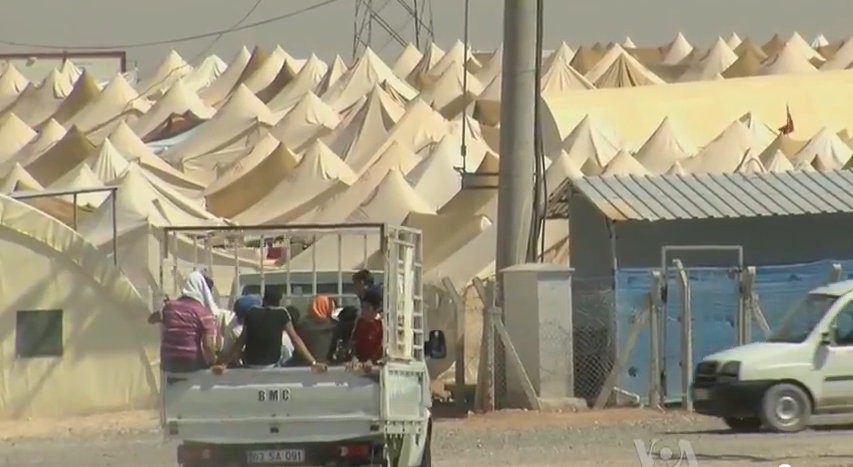380k Syrians Seek Asylum
Syrian Refugee Camp on Turkish Border. Photo via Wikimedia under the Creative Commons License. https://upload.wikimedia.org/wikipedia/commons/5/52/Syrian_refugee_camp_on_theTurkish_border.jpg.
Europe’s infrastructure continues to buckle under the influx of refugee souls from Syria, in what is shaping up to be the worst exodus since the Rwandan genocide. Since 2011, 4 million Syrians have escaped their war-torn motherland in search of a better home, but such efforts are littered with difficulties. The European Union has yet to find an agreement on how to equally distribute the refugees, exacerbating the situation as political sectionalism further complicates the crisis. Under the current system, the Dublin Regulation, refugees must apply for asylum in the country they first entered – causing poorer nations which are ill-equipped to handle the crisis, such as Greece, to shoulder most of the burden.
According to the UN Refugee Agency, over 380,000 refugees from Syria have reached Europe this year so far; a dramatic increase from the 216,000 arrivals in all of 2014. Most cross through the Balkans heading for Germany and end up in Hungary, where the Prime Minister, Viktor Orban, recently asserted the importance of tight border controls “to keep Europe Christian.” Orban is now under fire for his statement, but his fears are not exclusively rooted in xenophobia.
Hungary is a small, landlocked agrarian country, with just over 9.8 million inhabitants, and the Magyar administration is struggling to process events as they unfold. Train stations in Hungary are now overflowing with Syrians that are being denied access into the heart of Europe until their asylum requests can be processed under the Dublin Regulation, applications that Hungary does not have the infrastructure nor the time to quickly review. Altercations between the refugees and Hungarian police are quickly becoming more commonplace, with language barriers making it that much more difficult to maintain peace. To try and alleviate the situation, military police have begun placing registered refugees in temporary camps, yet barbed wire fences and police dog patrols only serve to mount anxiety among the detained Syrians.
Unfortunately, Hungary is a rather tame example. As of March 2015, Turkey has absorbed over 1.7 million Syrians under a temporary protection program, on account of the two nations sharing a border. Although the EU is in the process of proposing a mandatory quota system so that all nations in the union take on a share of refugees, the majority still end up in Turkey where $6.5 billion has been spent caring for the fleeing Syrians. Outside aid does attempt to help, but so far Turkey has only received a paltry $400 million (about 6.5% of the expenses) in assistance. Recep Tayyip Erdoğan, the Turkish president, has stressed the fact that their nation cannot afford to keep caring for the refugees as a long-term solution, and has called on the European powers to take up their fair share of the responsibility. As Turkey is not currently a member of the EU, whether or not the council will take this into consideration is up for debate.
But how did this mess start in the first place? Syria is a relatively new nation, and European powers designated its borders in the 20’s, after the fall of the Ottoman Empire in the 1st World War. Without regard for the ethnic or religious groups divided by the new artificial boundaries, France assumed control of the nation as an extension of its empire until 1942, when Syria joined the United Nations. Regrettably, the post-independence period in Syria was tumultuous at best, with coups rapidly adding instability to the region. This all changed in the 80’s, however, when the Assad regime took power. Although a dictatorship, the regime maintained a degree of stability until 2011, when the Arab spring caused protests in various cities, such as Deraa. Ordered by Bashar al-Assad, military police began firing upon squads of innocent protesters, giving rise to a rebellion movement.
To polarize the issue, Assad began exclusively targeting Sunni Muslims, the biggest demographic in Syria. Himself a Shia, Assad was hoping his blatant religious persecution would attract Sunni extremists, such as Al-Qaeda, to Syria – which would increase western support for his regime. Soon enough his plan got results, with Al-Qaeda uniting to defend Syrian civilians, eventually forming ISIS as they also swept through northern Iraq. Currently, Syria is divided between the rebels, Assad’s regime, ISIS, and the Kurdish, an ethnic group that are viciously fighting for their own independence. These warring factions continue to further destabilize the historically chaotic region, and there are no signs of the Syrian civil war stopping soon.
At the end of the day, there currently isn’t much that can be done about the crisis. Roughly 8 million Syrians are both internally and externally displaced, and until politics can make room for them, situations such as the crowded train stations in Budapest will only continue to worsen as more wayward souls seek refuge in Europe. Checkbook humanitarianism can only go so far, and even that is proving to be woefully inadequate as the primary caregiver, UNCHR, is several billion dollars short of their goals. The real fight lies in changing the viewpoints of citizens and politicians on large-scale immigration, and the challenge of relocating the refugees afterwards. It’s not an easy task by any means, but right now it’s the only real solution available.

Hi! You must be really bored if you're reading this, but here we go. My name is Sebastian Lloret and I'm a Senior at Air Academy this year. I speak English,...













Jenn • Oct 5, 2015 at 2:25 pm
Great information in this article. Nice job, very informative.